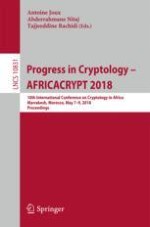2018 | OriginalPaper | Buchkapitel
HILA5 Pindakaas: On the CCA Security of Lattice-Based Encryption with Error Correction
verfasst von : Daniel J. Bernstein, Leon Groot Bruinderink, Tanja Lange, Lorenz Panny
Erschienen in: Progress in Cryptology – AFRICACRYPT 2018
Aktivieren Sie unsere intelligente Suche, um passende Fachinhalte oder Patente zu finden.
Wählen Sie Textabschnitte aus um mit Künstlicher Intelligenz passenden Patente zu finden. powered by
Markieren Sie Textabschnitte, um KI-gestützt weitere passende Inhalte zu finden. powered by
